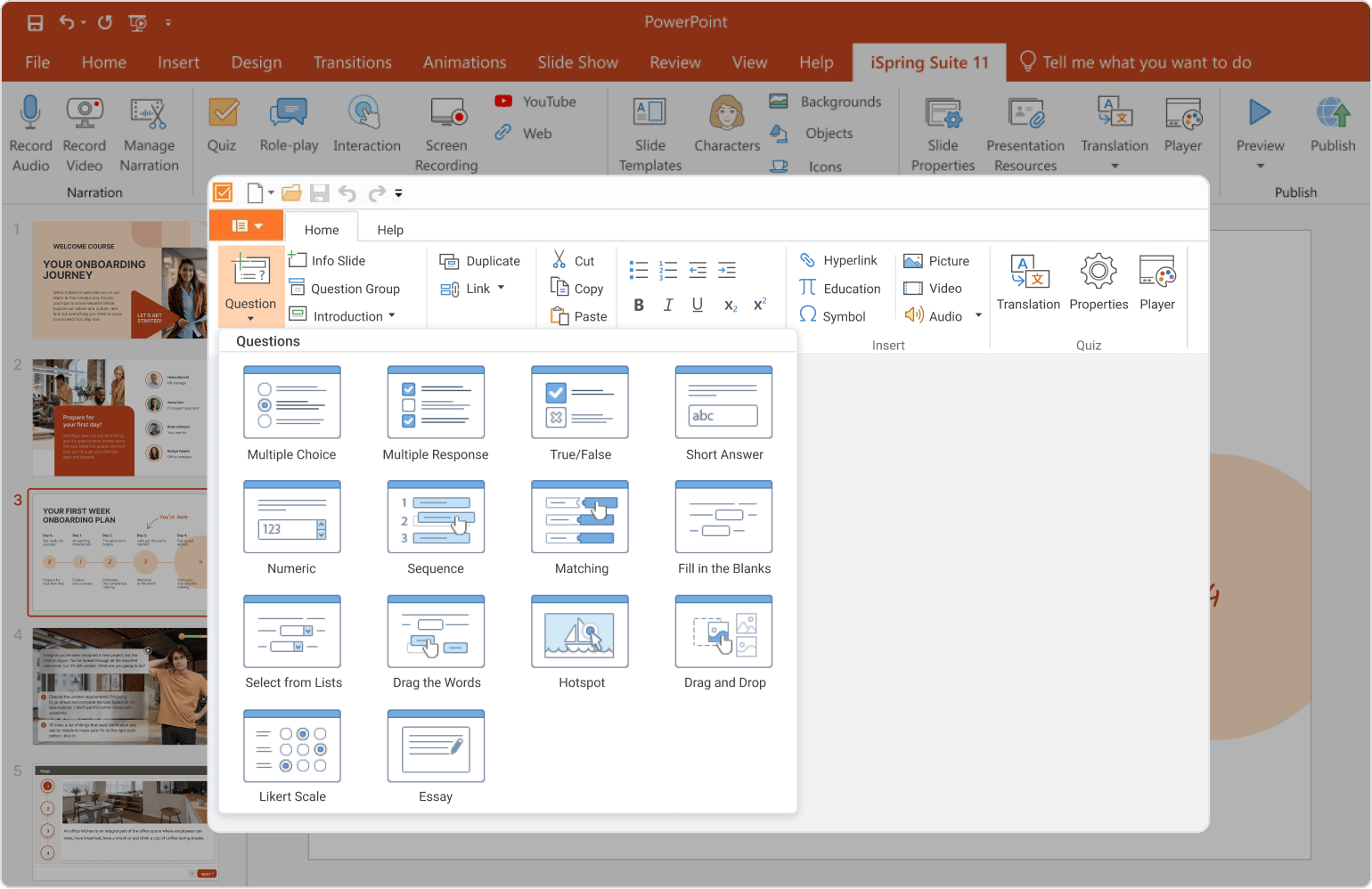Turning Conversations Into Closed Deals
Your sales rep failed a pitch and lost a client because they answered the wrong objection, and you only found out weeks later from a call recording. Does this sound familiar? If only you could have caught that mistake the moment it happened and let them retry on the spot, right? Well, that's exactly what quality sales comm training allows you to do. With the combination of solid instructional materials and interactive simulations, you can give your team a safe sandbox to practice, fail, and perfect every possible conversation before they ever pick up the phone.
Let's see how you can build effective sales communication courses to ace both trainee engagement and effective knowledge recall. With the right goals and a robust authoring tool like iSpring Suite, this process is both smart and simple.
Top Sales Communication Skills To Train
Before you start building simulations and quizzes, it helps to know exactly which conversation muscles you're strengthening. Here are some crucial skills every sales rep should sharpen to drive sales success:
- Active listening. When a rep listens closely and accurately and paraphrases the prospect's opinions and concerns, they feel heard. Active listening builds trust and can help sales professionals spot unspoken pain points.
- Open‑ended questioning. The difference between "Do you like our solution?" and "What challenges are driving you to explore a new solution?" can be fundamental. It's the pivot from a polite no‑thank‑you to an honest conversation about budget limits and stakeholder concerns. With that, the sales rep will know how to overcome the challenges on the way to a closed deal.
- Empathy. Great salespeople connect before they sell. When your course shows reps how to mirror a prospect's tone, you can turn scripted calls into genuine dialogues that lead to tangible results.
- Articulating a value proposition. It's not enough to recite the features of your product or service. Your reps need to weave benefits into a narrative that addresses each prospect's business needs. This is a skill that can turn a skeptical prospect into a satisfied client faster than a discount will.
- Objection handling (as a conversation, not a debate). Objections are inevitable, but very often they are opportunities rather than total roadblocks. By helping reps rehearse structured rebuttals, you show them how to keep the dialogue alive and focused on value.
- Closing techniques. From assumptive closes to trial closes, your reps need practice shifting from exploration to commitment without coming off as pushy. Closing the deal is an art form.
Choosing Formats That Engage And Stick
Another thing to keep in mind is that people learn best when they're actively involved. Explore various content formats of eLearning in sales training that cater to different learning styles and reinforce skills through practice:
- Slide‑based modules. These concise, visually driven lessons make it easy to introduce key communication concepts without overwhelming reps. Focused modules (aim for 5–7 slides) ensure that reps absorb one principle at a time and can revisit specific slides whenever they need a quick refresher on a technique.
- Interactive quizzes. Rather than passively reading rules, reps can test their understanding through drag‑and‑drop exercises, hotspot questions on call transcripts, or rapid‑fire multiple-choice questions. Plus, quick scores and feedback highlight knowledge gaps and help you tailor training to each rep's unique needs.
- Dialogue simulations. Branching role‑plays put reps in the driver's seat of customer conversations. These "choose‑your‑own‑adventure" scenarios mirror actual selling pressure and teach them that every word choice carries weight, but in a safer, risk-free environment.
- Video demonstrations. This format is a great way to provide examples of skilfully handled customer communication to emulate. Short clips (60–90 seconds) let learners study the tone, pacing, and body language they need to master. Allowing them to pause after key moments and ask questions turns passive viewing into an interactive coaching session.
- Scenario‑based stories. Multi‑step narratives can guide reps through an entire sales journey, from the initial outreach to closing the deal. These stories can be based on real client case studies and customer profiles.
You can combine several formats, depending on which skills and scenarios are relevant to your sales communication training. Moreover, a combination of different formats makes the training process more dynamic.
Building Your Sales Comm Course In iSpring Suite: 5 Simple Steps
Regardless of the type of communication skills you want to train or the formats you prefer, iSpring Suite makes course authoring both intuitive and effective. Follow these 5 steps to build solid sales comm training content, even with no Instructional Design skills.
1. Conduct A Training Needs Analysis
Begin with real data. Interview your sales managers and ask them:
- What mistakes do reps make during calls?
- Which skills feel the weakest?
- Which customer objections hit the hardest?
You can also review CRM records for more insights. For example, see if low win rates stem from early discovery gaps or breakdowns during closing. Compile this into a prioritized list of sales comm skills you need to develop or reinforce in your reps. You can dedicate one module to each skill in your course.
2. Draft Your Course Outline
Lay each module out on paper or a digital board. It can look like this:
- Concept overview (slides and voice‑over)
- Video demo (2–3 minutes)
- Interactive quiz (3–5 questions)
- Dialogue simulation (a 2-minute conversation with a customer)
- Reflection exercise (open‑ended prompt)
Flag which assets you'll need, including slide decks, video scripts, call center-style voice recordings, or character images. Collect the training content you already have (text-based scripts, presentations, and PDFs) to include it in your course.
3. Create Or Refine Training Content In iSpring Suite
iSpring Suite makes it easy to turn static, text-heavy materials into an engaging learning journey.
To create your course, download the iSpring Suite free trial and launch PowerPoint. iSpring Suite will appear as an additional tab on the top PowerPoint ribbon. There's no need to get used to a new tool because you'll work in the familiar PPT interface.
Now you can add your content to the slides and include images and video demos to make the training more dynamic. Instead of boring plain text, you can put together an interactive, visually appealing training project in a matter of minutes.

Pro tip: If you want to make your sales comm courses more relatable, add characters to your slides. With iSpring Suite's Character Builder, you can choose from a variety of characters and build your own to reflect your reps' cultural backgrounds, appearances, and even personal styles. This works wonders for trainee engagement and knowledge recall.

4. Enrich Your Course With Role-Plays
Did you know that retention rates for learning by doing can reach 75%? Role-play scenarios are a perfect example of this type of activity, and they come in handy when you need to practice key communication skills. Trainees can simulate actual conversations with customers and try out various sales techniques with zero risk.
You can create a role-play scenario with iSpring's dialogue simulation tool. These simulations leverage branching scenarios to yield unique responses based on the trainee's input. Build dialogue trees based on common sales scenarios and add characters and virtual scenes from the Content Library, and voilà—the role-play is ready!

5. Choose The Right Assessment Types
Don't forget about knowledge assessments to check your trainees' progress and understanding of key sales communication concepts.
Choose from 14 types of questions and create quizzes that reinforce knowledge retention but don't bore your learners. Then, pick the question templates that match your preferred assessment method and populate them with texts and media.
For objection‑handling practice, try hotspot questions that ask learners to click on the most effective response in a sample dialogue. For call structure assessments, use drag‑and‑drop ordering quizzes so reps can arrange the steps of a discovery call or trial close.

Pro tip: With iSpring Suite Max, you can use a personal AI assistant to instantly create both course content and generate quizzes based on your course text. This saves tons of time and helps you focus on more creative course-building tasks, like exploring branching scenarios.
Final Thoughts
Building communication skills training for a sales team is a great investment in your company's success. With new communication skills nailed down, you'll see faster ramp times for new hires, higher win rates, and increased rep satisfaction.
Remember to track your key training performance indicators like simulation pass rates and quiz averages, and revisit your modules every six months. It's always a good idea to update scenarios to reflect new market trends or solicit fresh video testimonials from star performers to keep your examples current.









